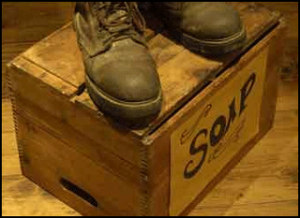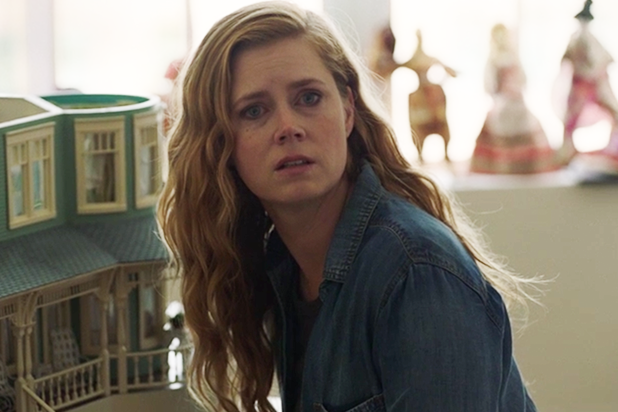Friendly Notice: The following post contains frank discussion and spoilers for the television mini-series Sharp Objects.

The past two summers have gifted us with heady, visually intriguing mini-series based on powerful works by women. Last year’s Big Little Lies, an adaptation of Lynne Moriarty’s 2015 novel broached the topic of domestic abuse, violence against women, and the repercussions–expected and unexpected–of that violence. This summer, HBO aired Sharp Objects, an adaptation of Gillian Flynn’s 2006 debut novel. Both productions were directed by Jean-Marc Vallée. They are both visually stunning, sensual, scenic productions that manage to convey as much (if not more) through silence than most productions do with pages and pages and pages of dialog. Sharp Objects was a languorous, slow-moving southern gothic that made you feel sweaty from the sweltering heat portrayed on the screen. Amy Adams’ performance was the stuff of legends and deserves applause, awards, and accolades.

However…
There be spoilers ahead, Matey!
(And let’s also note that we are talking about these shows as adaptations. While we understand that the book and its film are independent pieces of art, they can also be considered side-by-side, which we are doing here).
We really need to talk about these endings. (Seriously. Spoilers. You’ve been warned.)

Both Big Little Lies and Sharp Objects are the kind of stories where the ending redefine the entire story, forcing the reader to go back, rethink the story they have just read, and contemplate not only the truth that’s been lurking under the surface, but also about how their assumptions about “good guys” and “bad guys” affected their ability to recognize what was going on. They are clear, coherent, wonderfully intelligent, and thoughtful. However, one of the major themes that connect both shows are the plethora of headlines talking about the “abrupt” and “confusing” endings. So let me be clear: neither book has a confusing ending. In fact, they are both notable and noteworthy for the definitive statements they make about women learning to heal from trauma.
Let’s stick, for now, with Sharp Objects, since it’s the freshest in my (and perhaps your) memory–and also because I’m more angry at it right now. In the book, journalist Camille Preaker is sent back to her hometown to investigate the murder of a young girl and the disappearance of another. From the beginning, we learn that Camille is depressed, self-harming (she carves words on her skin), and self-medicating with alcohol. We learn that her younger sister, Marian, the undisputed ‘favorite child’ died of an unknown or unspecified disease, leaving Camille alone and forced to cope with her narcissistic, manipulative mother Adora. Her return home refuels all the old tensions within her family, but now, Camille is focused on her half-sister Amma, some twenty years her junior, who is trapped with their mother and clearly coping badly. Amma lives a double life: she acts out, takes drugs, and drinks (among other problematic behavior) outside, but in her house, Amma regresses, becoming a meek, innocent child that their mother can care for and manipulate.
 Over the course of the story, we learn that Camille’s mother Adora suffers from Munchausen syndrome by proxy, or, as it is now known, Factitious disorder imposed on another–a condition in which a caregiver develops a long-term mental disorder of a type involving a breakdown in the relation between thought, emotion, and behavior, and harms the person in their care in order to be perceived as a helpful, saintly, martyr figure. Adora herself was responsible for the death of Camille’s sister and, indeed, nearly kills Camille and Amma by feeding them a tonic containing rat poison. The daughters are saved at the last moment, Adora is arrested, and Camille takes Amma to live with her. Things seem fine until a girl at Amma’s new school is murdered, and Camille realizes that Amma was the murderer of the two girls, driven to violent rage when she though that the girls were getting more attention from Adora than Amma herself. Distraught after Amma’s arrest, Camille uses a knife to carve more words into her back and very nearly begins cutting her face. She is saved by her editor, who takes her in. At the end of the book, Camille is living with the editor and his wife, and learning how to be part of a stable, loving family for once in her life. For the record, this is a very watered-down version of the plot, and you should still read it.
Over the course of the story, we learn that Camille’s mother Adora suffers from Munchausen syndrome by proxy, or, as it is now known, Factitious disorder imposed on another–a condition in which a caregiver develops a long-term mental disorder of a type involving a breakdown in the relation between thought, emotion, and behavior, and harms the person in their care in order to be perceived as a helpful, saintly, martyr figure. Adora herself was responsible for the death of Camille’s sister and, indeed, nearly kills Camille and Amma by feeding them a tonic containing rat poison. The daughters are saved at the last moment, Adora is arrested, and Camille takes Amma to live with her. Things seem fine until a girl at Amma’s new school is murdered, and Camille realizes that Amma was the murderer of the two girls, driven to violent rage when she though that the girls were getting more attention from Adora than Amma herself. Distraught after Amma’s arrest, Camille uses a knife to carve more words into her back and very nearly begins cutting her face. She is saved by her editor, who takes her in. At the end of the book, Camille is living with the editor and his wife, and learning how to be part of a stable, loving family for once in her life. For the record, this is a very watered-down version of the plot, and you should still read it.
The mini-series which aired on HBO (and concluded on Sunday) ends with Camille discovering vital (and horribly gruesome) evidence of Amma’s guilt concealed in Amma’s creepy-as-sin dollhouse. Abruptly, we see Amma standing in the doorway. She whispers “Don’t tell Mama,” before a brutally quick cut to the credits. The only indication we have about the reality of Amma’s actions are a series of rapid-fire, hazy cuts that implicate Amma and her two friends in the deaths of the girls in Windgap, and Amma alone in the death of her friend from school. The final shot of the entire episode is Amma’s face.
There have been a number of critics who have taken issue with this ending for its style, for its glamorization of Amma’s cruelty, for its ambiguity. There is a lot to be said about this show, and this story, from the reality of female rage, the importance of telling women’s stories without pretense, or, indeed without needing male characters to justify their behavior. But what has gone largely overlooked here, is how it destroys the real power of Sharp Objects‘ ending.

As we’ve pointed out here before, there is a troubling, pervasive trope of women victims in fiction–not only in mysteries, but they remain a primary offender. For time immemorial, we have been treated to the image of a women’s silent body, violated and harmed. We have been taught that women endure pain as a permanent condition–think of Miss Havisham forever in her wedding dress; or Bertha Mason in the attic; or any female ghost who ever haunted a house. Women are vessels for pain in fiction, and we are taught to see that pain as inescapable.
Gillian Flynn flipped this trope on its head in Sharp Objects. From the beginning of the story, it seems that Camille is another damaged woman, trapped in her own pain. This is a character who quite literally carved her pain into her own flesh, making her skin both an armor against the world and a cage from which she can never (apparently) break free. In the show, we also learn in far more detail about the harm Camille endured as a result of the people in her town–yet another trap keeping her from healing. At the book’s end, however, we see that Camille has learned that there is a way out from the horrible cycle of illness, anger, self-loathing, and self-deception that her family and her town practice. She is given the choice and the opportunity to grow and heal–and she takes it.
That opportunity, that choice, that hope, is taken away from her in the mini-series. By giving us Amma’s face at the end of the show, Sharp Objects is no longer Camille’s story. Instead, she facilitates a story about Amma and Adora, and the ways in which violence destroys people, ruining the idea of a “pure victim.” This is not to say this is not an important trope. But to take away Camille’s hope is to perpetuate the notion that women in fiction (that women in general) suffer without resolution, and without real choice. To take away the book’s ending is to dilute the shocking feminist ending of Sharp Objects in favor of a far more problematic one. The miniseries states that women can be anything–victim, murderer, villain, or bystander. Again, this is fine. But the book says that women can change. And that is vital.

I could not agree with you more. Amy Adams was brilliant.The story was intense.The viewer at the end, was simply left to wonder………